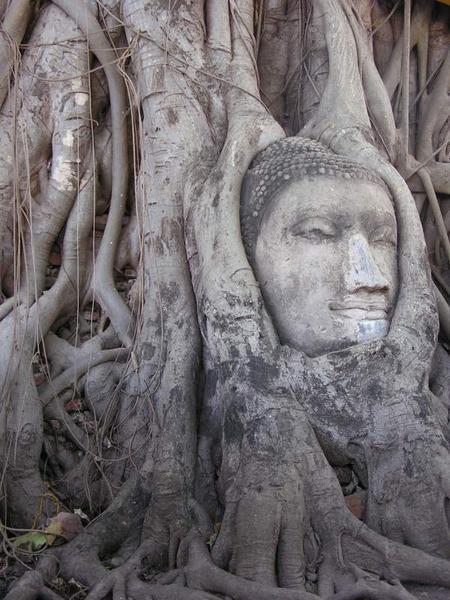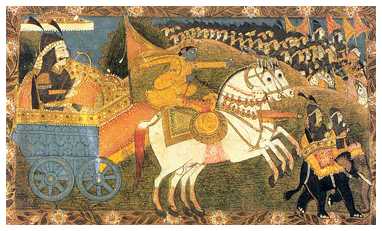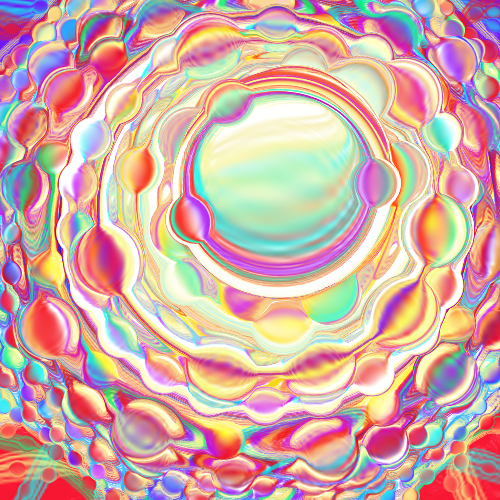The World Tree - Axis Mundi & Attaining the Supreme
This is That eternal Asvattha Tree with its root above and branches below. That root, indeed, is called the Bright That is Brahman, and That alone is the Immortal. In That all worlds are contained, and none can pass beyond. This verily is That.
- Katha Upanishad II.iii.1
In the beginning verses of Book XV, Krishna teaches his friend Arjuna the understanding of the Tree of the Universe or the Tree of Samsara. Samsara is this relative universe with its endless cycles of births and deaths. This tree is upside down (XV.1). Its roots are above (urdhva) and its branches below (adhas).
... the Asvattha, ...
Which hath its boughs beneath, its roots above, -
The ever-holy tree.
- Ganguli XV.1
 Asvattha is the Sanskrit name for
the Peepal (fiscus religious) fig tree and is familiar to all Indians. It has
heart-shaped leaves and its fruit is purple when ripe. The Peepal tree was
first depicted on a seal discovered at Mohenjodaro, a city of the Indus civilization (3000 BC - 1700 BC). Its leaves are applied to wounds after being heated
in ghee. It sends its branches down to the earth below, and is the Buddha’s
Bodhi tree
Asvattha is the Sanskrit name for
the Peepal (fiscus religious) fig tree and is familiar to all Indians. It has
heart-shaped leaves and its fruit is purple when ripe. The Peepal tree was
first depicted on a seal discovered at Mohenjodaro, a city of the Indus civilization (3000 BC - 1700 BC). Its leaves are applied to wounds after being heated
in ghee. It sends its branches down to the earth below, and is the Buddha’s
Bodhi tree
Yea! for its leaves
Are green and waving hymns which whisper Truth!
Who knows the Asvatta, knows Vedas, and all.
- Ibid.
Krishna says that the leaves of this metaphorical tree are the sacred hymns of Vedas. Its branches are nourished by the three gunas (guna-pravrddha) and its twigs (pravalas), which sprout branches are said to be the objects of the five senses (visaya). In Samkhya, the things of this world are never separate from the senses, through which they are perceived. It is the ‘operation’ of the five senses on ‘their’ objects that makes the temporal illusory hologram perceptible to our human consciousness.
The roots of the upside-down Tree of Samsara stretch downward from above as our desire-based actions bind (karma-anubandhini) us to this earth, the human world (manusyaloke). The upside-down tree is also a metaphor for the mirror image of the unreal which is only a reflection of the Real.
The trunk is formed by ‘the various subtle bodies of living beings’
 This Tree of the Universe
(Samsara) is said to be noisy ‘constantly reverberating with the tumultuous’
sounds that arise from the cacophony of all human activity. Its trunk is formed
by ‘the various subtle bodies of living beings.’ Its growth is fed by desire
and its fruits are the Lokas, the worlds of the afterlife, which are
experienced as the reward for actions (Sankaracharya as translated by
Nikhilananda).
This Tree of the Universe
(Samsara) is said to be noisy ‘constantly reverberating with the tumultuous’
sounds that arise from the cacophony of all human activity. Its trunk is formed
by ‘the various subtle bodies of living beings.’ Its growth is fed by desire
and its fruits are the Lokas, the worlds of the afterlife, which are
experienced as the reward for actions (Sankaracharya as translated by
Nikhilananda).
Thus the longing for results, the fruits of our acts, engenders the roots which reach down into the earth plane and further bind human consciousness in the temporal illusory hologram.
Its branches shoot to heaven and sink to earth,
Even as the deeds of men, which take their birth
From qualities [gunas]: ...
... As actions wrought amid this world of men
Bind them by ever-tightening bonds again.
- Ganguli XV.2
The form of the Tree of the Universe cannot be known by living beings here on earth (XV.3). It has no beginning (adih) and no end (antah), nor can its continual existence be perceived. This Tree forms the link between the transcendental worlds and the phenomenal ones.
The Sharp Axe of Detachment
The Tree of Samsara is an illusion, the projection of the Immutable Immeasurable Imperishable Oneness. When Souls are weary of enjoying the experiences provided by transmigration through a myriad of births and deaths, they must learn to discern the Real from the effects of guna-maya and cut down this Tree. The only way to cut this upside-down Tree is with the Axe of Non-attachment (asange-sastrena).
The Sanskrit word asange means that which is opposed to desire, and sastrena is an axe or knife like weapon. Dispassion and renunciation of the signals which transmit the perceptions of the five senses to the brain, become a mighty (drdhena) weapon (sastra) because they detach human consciousness from the world of desire, attachment and aversion, likes and dislikes, pleasure and pain (Gambhirananda).
An eagerness for Knowledge of the Supreme Self makes this Axe strong and the repeated practice of Discriminations between the eternal Real and the temporal unreal, produced by Prakriti’s guna-maya, sharpens the weapon that cuts down our attachment which binds us in the temporal illusory hologram (ibid.).
The World Tree - Axis Mundi
Krishna’s Asvattha Tree, the Tree of the Universe or Samsara, is none other than the World Tree, the Axis Mundi known in every metaphysical understanding through the ages around the planet. The brilliant metaphysical writer Rene Guenon says that Krishna’s upside-down Ashvattha tree refers to the primordial traditions symbolized by the sacred oak for the Celts, the lime tree for Germans, and the ash for Scandinavians (Man & His Becoming According to Vedanta).
Guenon explains the upside-down position of the tree as ‘analogy, here as everywhere else, [that] must be applied in an inverse sense.’ Like the Hanged Man card in the Tarot, what is true for the inner spiritual reality is inverse to the external material one. Guenon says that the roots are above because they stand for ‘the Principle’ and the branches spread out below to ‘represent the deploying of manifestation’ (ibid.).
The Symbol of the Cross
The Tree as World Axis is the true meaning of the symbol of the cross. The vertical line represents the axis and the horizontal ‘forms its branches’ (R.Guenon; The Symbolism of the Cross). The Hebrew Kabbalah has their Sephirothic Tree of Life.
Guenon states that this tree ‘stands at the center of the world, or rather a world.’ Wherever a ‘state of existence, such as the human state, is developed’ (ibid.) you will find the Tree as the Axis of that state, that world.
Perhaps it is useful to think of fractals, or dimensions within dimensions all existing simultaneously, or the traditional concepts macrocosm and microcosm. The Tree is the Axis of the Matrix that is the structural womb of the temporal illusory hologram. Every piece of the hologram contains the entire hologram; thus the Tree also exists within you, and is there to be seen with the Inner Eye.
The Tree of the Universe is the metaphysical reality on which all the myriad existences are formed. The total lack of knowledge of this Truth is the source of all that has gone wrong in science and in our modern world. Ignorance of the World Axis is itself a symptom of the Kali Yuga and what Rene Guenon with precise insight calls the Reign of Quantity.
Go beyond the Tree
The state of being (padam - place or footing) that is beyond this illusory Tree of Samsara is to be sought. Those who attain, who have gone to (gatas) this abode beyond the Tree, they do not again return (nirvartanti) to the world (XV.4).
ततः
पदं
तत्परिमार्गितव्यं
यस्मिन्गता
न
निवर्तन्ति
भूयः
.
तमेव
चाद्यं
पुरुषं
प्रपद्ये
.
यतः
प्रवृत्तिः
प्रसृता
पुराणी
.. १५-
४..
tataḥ padaṃ tat parimārgitavyaṃ
yasmin gatā na nivartanti bhūyaḥ
tameva cādyaṃ puruṣaṃ prapadye
yataḥ pravṛttiḥ prasṛtā purāṇī 15.4
Those who seek release from the endless rounds of birth and death take refuge (prapadye) in the Primordial (adyam) Being (Purusha) - ‘Who made the mystery of old Creation’ (Ganguli XV.4) - from which have flowed like streams, the ancient (purani) currents, the frequency waveforms of creation.
No longer grow at mercy of what breeze
Of summer pleasure stirs the sleeping trees,
What blast of tempest tears them, bough and stem:
To the eternal world pass such as these!
- Ganguli XV.5
 The wise ones who have cast off
the veils of delusion (amudhah), go the imperishable (avyayam) abode (padam).
They have become free from pride and arrogance (nirmana). They have conquered
attachment (sanga).
The wise ones who have cast off
the veils of delusion (amudhah), go the imperishable (avyayam) abode (padam).
They have become free from pride and arrogance (nirmana). They have conquered
attachment (sanga).
Abhinavagupta states that it is the ‘deep-grown roots’ of the Tree of Samsara that must be cut, the roots which have been produced by ‘both good and bad action’ by limited human consciousness. Such cutting symbolizes the liberation from all attachment (B.Marjanovic).
The wise who have attained liberation from attachment dwell eternally in the Supreme Self (adhyatma) beyond the dualities produced by desire, beyond happiness and misery (XV.5) - sukhaduhkha is often written as one word!
Another Sun gleams there! another Moon!
Another Light, - not Dusk, nor Dawn, nor Noon -
Which they who once behold return no more;
- Ibid.XV.6
Verse six can be interpreted in two ways. One is simply that the Supreme Abode or Home (paramam dhama) of the Lord is not lit by the Sun (suryah) or the Moon (sasankas), or even fire because these are the products of time and space. The abode of the Supreme Being is beyond both.
A further interpretation rests in the experiential inner visions of the Light that is self-effulgent. There is no reflected light beyond the polarity based earth plane. There are many realms which also do not appear as reflected light and possess a visual quality as if lit from within, somewhat like an animated cartoon. Their translucence and density vary relative to the frequency of consciousness they emit. Some resemble the strange ‘plastic’ quality of light in computer animation.
The Self-Effulgent Illuminator of All!
However only the Lord is self-effulgent, self-luminous. For it is That Light which is the Illuminator of all others. Every universe and all creations arise from the Surpeme Bliss of the One.
The Sun does not shine there, nor the Moon and the stars, nor do these flashes of lightning shine - nor this fire. He shining, everything shines after Him [Brahman as IS-ness]. By His Light all this is variously illumined.
- Katha Upanishad II.ii.15; Gambhirananda translation
Krishna assures Arjuna that those who go to the Supreme Home (paramam dhama) of the Lord do not return (XV.6). Once you have found your way Home and have Realized your real identity as the Supreme Self (Paramatman), merging your consciousness fully with That which is imperishable, self-effulgent Bliss, you do not return to the wheel of transmigration, birth and death through the endless Cycles of Time.
The Bodhisattva
This declaration of not ever returning to a human incarnation brings up the question of the Bodhisattva. Surely there are those who out of compassion for others will choose to delay their own enlightenment or will return to corporeal form to assist in the enlightenment of others before their final liberation.
It may be that their mere presence is enough - especially in a Kali Yuga - to help balance the oppressive influence of the darkside demonic. Or they may take on an active role and work for the well-being of the world (lokasamgraha) in the spirit of passionate non-attachment. What matters is the effort, meaning the consciousness the effort springs from; the results remain subject to the fabric of the hologram.
With a mere fragment ...
The One, the Supreme Self (Paramatman), becomes an individual living being with a ‘mere fragment’ (amsah -Winthrop Sargeant) of Its own eternal Self. Paramatman the One becomes Atman as the multitude of Selves - which are the fragments, parts, pieces that are a share in the One. The Atman is known as jiva and Purusha once it enters a corporeal form. This world of the living is jivaloka.
In jivaloka the One as the many draws to Its Self the senses (indriyani), the sixth of which is said to be the mind. As a fragment (amsah) of Its Totality, the Atman takes on the consciousness of limitation which is in fact a temporal illusory appearance in the holographic matrix (XV.7).
The undying Spirit, setting forth from Me,
Taketh on form, it draweth to itself
From Being's storehouse, - which containeth all, -
Senses and intellect.
- Ganguli XV.7
The Lord (Paramatman) as Atman acquires (avapnoti) and enters into a body (XV.8). The Lord, Isvarah, is the true master and owner of the aggregate of the body and the sense organs (Gambhirananda). When the Atman or Soul leaves (utkramati) a particular body, the sense organs and the mind are taken along like fragrances (gandhan) of perfumes carried on the wind (vayu).
It is this ‘fragrance’ that creates the magnetic alignment that pulls you into the next body. Your subtle body is magnetized to a resonant DNA which was created through the experiences of multiple lifetimes, one building upon another passed on through the genes.
Transmigration - not reincarnation
Therefore when you recall past lives, what you are actually seeing are the lives of the body you currently inhabit. This is the basis of ancestor worship. Those holograms of the lives in your DNA do resonate with the template-like-form of your own cumulative experiences. It’s a bit like finding the perfect car that in every detail suits your personality. Your soul (Atman) transmigrates. The small personality ego-self does not reincarnate.
Abhinavagupta states that this retaining of the sense organs and the mind, as they are taken from one body to the next, is a function of the subtle body (puryastaka - B.Marjanovic).
The Sovereign Soul
Thus entering the flesh, or quitting it,
Gathers these up, as the wind gathers scents,
Blowing above the flower beds.
- Ganguli XV.8
The Supreme One - who has taken on the appearance of multiplicity as the myriad Selves, the Atman, who in reality never leaves Its consciousness that is the Absolute - enjoys (upasevate) the objects of the senses (visayan).
As the Atman, the Supreme Self (Paramatman) presides over (adhisthaya) the five senses: hearing (strotram), sight (caksus), touch (sparsanam), taste (rasanam), and smell (gharnam) - and the mind (manas). The five senses work on their objects to transmit signals to the sixth, the brain (XV.9).
Ear and Eye,
And Touch and Taste, and Smelling, these it takes, -
Yea, and a sentient mind; - linking itself
To sense-things so.
- Ibid.XV.9
God dwells in the Heart of everyone, but most of us are not conditioned to ‘see God in every eye.’ If we did recognize our own Self in every man, woman and child, in every living creature, and every insentient thing, in mountains, rocks, trees, rivers and oceans - there would be no war and no destruction of the environment. The moment you Recognize the God within you as the same God within All, there is only Love.
The Eye of Knowledge
 Those who are deluded (vimudhas)
do not see that it is God who dwells in all forms, in all bodies. They do not
see God as the Soul (Atman) when at death It leaves the body. The deluded do
not recognize that it is God, veiled in a myriad of mere fragments of Its
Immeasurable Immensity, that enjoys (bhujanam) the experience of the gunas
(gunanvitam) operating on their objects through the senses. Only those who have
the ‘Eye of Knowledge’ (jnanacaksusas) see God in every eye (XV.10).
Those who are deluded (vimudhas)
do not see that it is God who dwells in all forms, in all bodies. They do not
see God as the Soul (Atman) when at death It leaves the body. The deluded do
not recognize that it is God, veiled in a myriad of mere fragments of Its
Immeasurable Immensity, that enjoys (bhujanam) the experience of the gunas
(gunanvitam) operating on their objects through the senses. Only those who have
the ‘Eye of Knowledge’ (jnanacaksusas) see God in every eye (XV.10).
The unenlightened ones
Mark not that Spirit when he goes or comes,
Nor when he takes his pleasure in the form,
Conjoined with qualities; but those see plain
Who have the eyes to see.
- Ibid.XV.10
Krishna clarifies for Arjuna how one develops the Eye of Knowledge, for it is not enough to engage in endless practices if you have not purified your consciousness (XV.11). Spiritual practices that are done in attachment for results or for the enhancement of the small ego-self will not bring perfection.
Holy souls see
Which strive thereto. Enlightened, they perceive
That Spirit in themselves; but foolish ones,
Even though they strive, discern not, having hearts
Unkindled, ill-informed!
- Ibid.XV.11
Identify your consciousness with and as the Lord that abides (avasthitam) in the Self (Atman). No amount of practices or external rituals and ‘initiations’ will succeed until you alone, by your own efforts shift your consciousness into the Heart and Immerse your Being in the God-within.
The Katha Upanishad
The Upanishads, Vol. One
Translated by Swami Nikhilananda, 1949
Ramakrishna-Vivekananda Center; 2003, NY
Man & His Becoming According to The Vedanta
Rene Guenon, 1925
Sophia Perennis, 2001; Ghent, NY
The Symbolism of the Cross
Rene Guenon, 1931
Sophia Perennis, 2001; Ghent, NY
The Reign of Quantity
Rene Guenon, 1945
Sophia Perennis, 2001; Ghent, NY
A walk through Mohenjodaro
http://www.harappa.com/har/moen0.html
